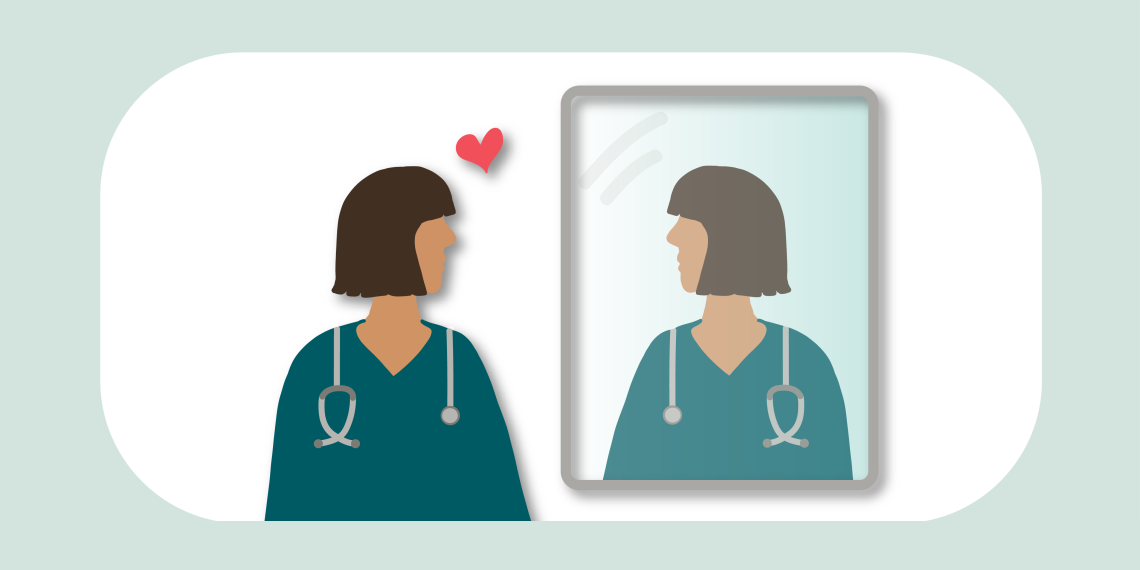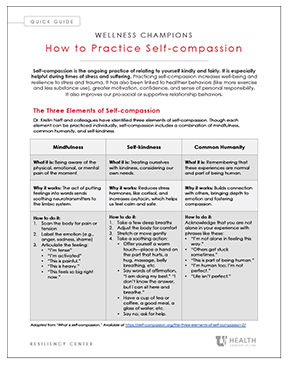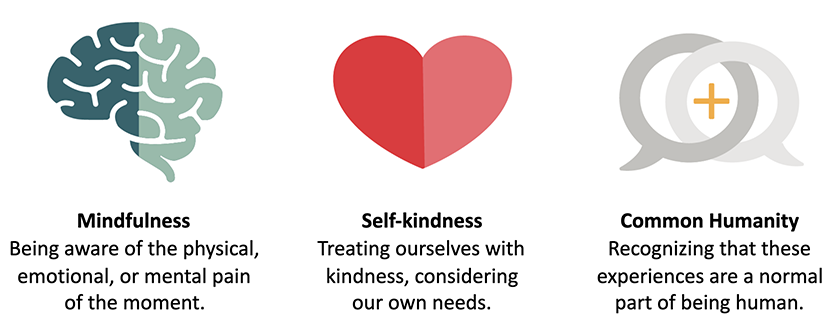

We can be so hard on ourselves. Contributors from the Resiliency Center share how self-compassion, the practice of being kind and fair to yourself during times of stress, can improve your well-being and resilience.
Jean Whitlock, Trinh Mai, Megan Call, and Jake Van Epps Feb. 4, 2021 4 minutes
elf-compassion is the ongoing practice of relating to yourself kindly and fairly. It is especially helpful during times of stress and suffering. Self-compassion is not kicking yourself when you’re down, which prolongs stress reactions, creates more suffering, and delays your ability to get back up. Instead, self-compassion is about treating yourself as you would treat a good friend in distress. It is about responding with caring support. Dr. Kristin Neff and colleagues have identified three elements of self-compassion:

Self-compassion increases well-being and resilience to stress and trauma. It has also been linked to healthier behaviors (like more exercise and less substance use), greater motivation, confidence, and sense of personal responsibility. It also improves our pro-social or supportive relationship behaviors. In short, practicing self-compassion is essential for health care teams.

Click here for a list of resources you and your team can use to practice mindfulness and increase your well-being.
Overcoming health care’s “Hero” culture Health care has a history of “hero” culture—giving everything of oneself at all costs. This culture is fraught with myths that can hurt our own well-being and that of our colleagues and patients.
| Myths | What the research 1 suggests: |
|---|---|
| Self-compassion is a form of self-pity. | Self-compassionate people tend to brood less about their misfortune. 2 |
| Self-compassion means weakness. | “Self-compassion is one of the most powerful sources of coping and resilience available to us. When we go through major life crises, self-compassion appears to make all the difference in our ability to survive and even thrive. 1 " |
| Self-compassion will make me complacent. | Self-compassion strengthens personal accountability. 3 |
| Self-compassion is narcissistic. | “Self-compassionate people are better able to remain emotionally stable, regardless of the degree of praise they receive from others. 4 " |
| Self-compassion is selfish. | “Self-compassion helps people sustain the act of caring for others. 1 ” |
For supported practice, take a Mindfulness in Medicine or Self-Compassion Course. Click here for more info.
Though each element can be practiced individually, self-compassion includes a combination of mindfulness, common humanity, and self-kindness. Use the drop-down boxes below to learn more about how to practice each of these elements.
Mindfulness What it isMindfulness is being aware of and acknowledging our emotions. Recognize the physical, emotional, or mental pain of the moment by labeling an emotion, tuning into the body, or using a phrase to describe or reflect what you are feeling.
Why it worksLabeling thoughts, feelings, or sensations has a powerful effect on the brain. Research on affect labeling, sometimes called “name it to tame it,” has found that the act of putting feelings into words sends soothing neurotransmitters to the limbic system. Mindfulness helps us know what we’re dealing with; accurate assessment and diagnosis leads to appropriate treatment and faster recovery.
How to practice mindfulness
Click here to learn about three ways we can build habits that support individual resilience.
Common humanity
What it isWe tend to feel alone during challenging experiences or emotions. We may ask, “Why me?” Or, “What’s wrong with me?” These questions only add salt to the wound. Recognizing your common humanity means remembering that these experiences are normal and part of being human. You are not alone.
Why it worksRecognizing your common humanity helps you connect with others, access the depth of your emotions, and develop compassion.
How to reflect on common/shared humanityAcknowledge that you are not alone in your experience with phrases like these:
Self-kindness
What it isWhen we consider our own needs we are being kind to ourselves. Self-kindness can take many forms, such as rest, asking for help, letting something go, setting boundaries, doing something fun, advocating for yourself, apologizing, or taking accountability.
Why it worksCaring for your pain helps to minimize harm while helping you bounce back faster. According to research, some methods for practicing self-kindness, like a warm touch or caring words, can reduce stress hormones, like cortisol, and increase oxytocin, which is correlated with connection, calm and safety.
How to practice self-kindness1. Take a few deep breaths
2. Adjust the body for comfort
3. Stretch or move gently
4. Take a soothing action
Self-compassion is associated with many of the same benefits as self-esteem, with none of the drawbacks of self-esteem, like narcissism and bullying behavior. For example, self-esteem, which is the practice of evaluating ourselves positively, is usually based on a comparison. Because it is based on a comparison it is vulnerable to ego threats and can actually break down during moments of failure or suffering. But self-compassion’s strength is specifically for these moments where resilience is needed most.
By acknowledging our inner experiences, fostering benevolence towards ourselves, and sharing our suffering, we are more likely to keep a growth mindset and learn through difficult experiences. Self-compassion facilitates psychological strength during difficult times, better preparing us for future challenges.
By Trinh Mai and Jean Whitlock
By Trinh Mai and Jean Whitlock
It may feel awkward or challenging at first to turn towards pain and offer support to yourself. Remember that it takes practice to feel comfortable doing something new. Be flexible as you develop self-compassion. Start small. For example, you can practice with milder stress.
Remember, self-criticism comes more easily than self-kindness. Those criticisms are likely to keep emerging. When they do, acknowledge the critical voice, give it limited time and attention, and then invite in the friend’s voice to help you bounce back more effectively and efficiently.
Talk about it. Bring up the topic before problem-solving or debriefing. Share some of the facts and mention the myths. (“Self-compassion helps with resilience.”)
Encourage each other. Build a supportive culture by reminding each other to respond to ourselves with compassion. (“What would you say to someone else if they were in this situation?”)
Recognize acts of self-kindness when checking in with teams or individuals. (“I’m so glad to hear that you are taking time to recover on your days off.”)
Incorporate this skill with other exercises from the Wellness Champions toolkit, like check-in questions and the positive psychology tools.
Get creative! Use an audio guide in a meeting. Invite the Resiliency Center to facilitate a “self-compassion break” during a huddle or meeting. Put up the quick guide companion to this article in common areas.
Watch this mindfulness meditation led by Trinh Mai to guide your self-compassion break.